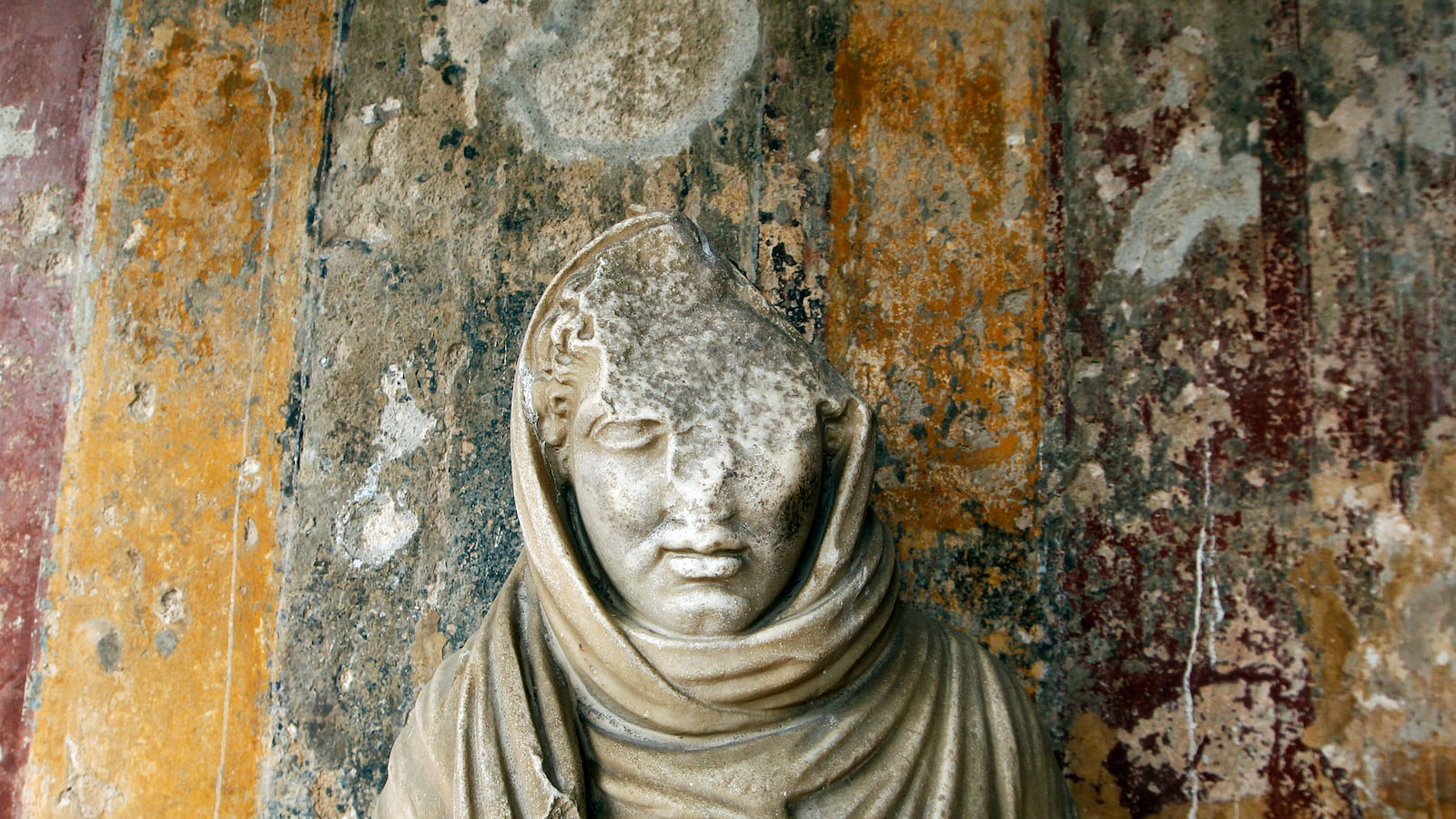One might argue that Pompeii has never been quite the same since the catastrophic eruption of Mt. Vesuvius in 79 A.D. that buried it under 25 meters of ashen dust. But centuries of painstaking excavations and anthropological study have brought about 75 percent of the once-dead city back to a splendid life, making it one of the most important archeological sites on the planet.

Since around 1994, when Italy’s state budget was too stretched to keep up preventative restoration, the ruins have been in a steady state of decline, ruined even more by around 50 significant collapses of walls and rooftops that somehow survived the volcano but couldn’t stand up to modern neglect. Now, the ruined ruins face a new threat: thieves who are stealing what’s left of its glory. And Pompeii isn’t the only ancient wonder being pilfered. Sites all over Italy are being picked at and destroyed by those meant to protect or appreciate them.
The latest known larceny in Pompeii happened sometime before March 12, when a guard doing a routine check of the ruins noticed that an 8-inch-square chunk of a fresco depicting the goddess of Artemis, the Greek goddess of wilderness and hunting and later of childbirth, had been plied off the wall of the House of Neptune.
The area was not under video surveillance—like much of the site—and it was closed off to the public after several catastrophic collapses due to heavy winter rains. Local police working with culture-ministry detectives dispatched to the site believe the perpetrators had little trouble entering the restricted area. Pompeii is comprised of a confusing labyrinth of narrow stone streets that are walled off in some places by fences and gates that are not exactly secure. Whoever removed the chunk used a metal object like a screwdriver or chisel that would never have made it past the metal detectors at the entrance of the ruin, leaving authorities to believe that it could have been an inside job—or the thief simply found a tool somewhere among the ruins.
So far there are no leads, but it seems unlikely that it will be sold in the open market. “It was no doubt intended for a private collector,” says Antonio Irlando of Italy’s Observatory for Cultural Patrimony.
During a similar theft in 2003, authorities tracked down stolen frescoes pried from the walls of the House of the Chaste Lovers that had already been packed in boxes to be exported to a private buyer in North America. Then, police found remnants of a takeout pizza box at the site where the frescoes were stolen and were able to inquire with the local pizzeria to narrow down just who the thieves were. The recent bandits didn’t leave such an easy trace.
By strange coincidence, or perhaps as a warning, another stolen fragment of fresco was mailed anonymously to the office of the superintendent in late January. Authorities had not noticed that missing fresco, which had been taken from the House of the Orchard, until it was returned. “The problem is one of human resources,” Massimo Osanna, the site’s new superintendent said in a statement after the discovery of the latest theft. “There is some video surveillance, but there are no guards. If a tourist climbs over a fence and finds himself directly into an area where it is no longer visible, anything can happen.”
Pompeii is an easy target because of its size and because it is badly guarded. But it is not the only Italian site that has been pilfered in recent months. Last week, four Canadian teenagers on a school trip were caught with stone from the ancient Roman Coliseum’s façade and a tiny piece of ancient ceramic in their backpacks. A vigilant tourist snapped a picture on her cellphone and showed guards who caught the kids before they could escape. The week before, a tourist visiting the Brera Academy in Milan broke the leg off a Greco-Roman statue while trying to take a selfie. Late last year, robbers even stole the blood of late Pope John Paul II from a church in Abruzzo. Airport officials at Rome’s Fiumicino Airport told The Daily Beast that they find stolen cobblestones, mosaics and other ancient artifacts almost daily during airport security checks. “People want to take a piece of history to remember the city,” an Aeroporto di Roma spokesperson told The Daily Beast. “Tourists feel it is their right to take something back home.”
Because much of the country’s glorious ruins are housed in what are essentially open-air museums scattered across the country, Italy’s cultural ministry says there is little it can do to stop tourists from taking bits and pieces from sites without actually closing the venues down altogether. In recent years, the ministry has instead focused on tomb raiders who steal larger artifacts still buried in the ground to sell them to museums and private art collectors, which is estimated to turn over more than $275 million a year. Just last weekend, Italian police captured two such tomb raiders pillaging an ancient Etruscan tomb with artifacts worth millions of euros late at night near the town of Viterbo, after learning that a private art collector had essentially “ordered” some Etruscan vases.
European officials have urged Italians to be more vigilant. “They have robbed all citizens, both Italian and European, of a priceless heritage that belongs to future generations,” European Commission Culture Minister Androulla Vassiliou said in a statement. But with more than 46 million people visiting Italy each year, it is almost impossible to keep track of the tourists in search of the ultimate souvenirs—a piece of history.






